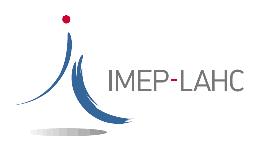All opportunities
Search...
Offers : 1
(filled) Modeling and simulation of superconducting phi-junctions and bi-SQUIDs
Start date : 29/01/2018
offer n° IMEPLaHC-01232018-CMNE
 MASTER INTERNSHIP 2018
MASTER INTERNSHIP 2018 
Modeling & simulation of superconducting phi-junctions and bi-SQUIDs
The Laboratory of Microwave and Characterization (IMEP-LAHC, CNRS UMR 5130) of Université Savoie Mont Blanc located in the French Alps area develops ultrafast energy-efficient superconducting digital circuits that work with clock frequencies of several tens of GHz, based on the Rapid Single-Flux Quantum (RSFQ) technology. Such circuits use a binary dynamic logic derived from the underlying physics of shunted Josephson junctions in free-running mode. In present of forced oscillations the strong non-linearity of Josephson junctions leads to the generation of harmonics or frequency mixing depending on the input signals. These effects are used for instance in radioastronomy and have enabled the development of quantum-sensitive terahertz (THz)
receivers, used at the focal point of ground-, balloon- and space-based telescopes.
The objective of this internship is to go one step further and develop new kinds of devices for usage in several additional domains, like security, medicine or telecommunications systems. That is possible by combining analogue and digital devices to build all-superconducting mixed-signal systems. Such developments can also be interesting for the readout of quantum-accurate imagers, magnetometers or quantum computing systems.
The objective of this internship is to focus on two relatively new types of superconducting devices, namely phijunctions [1] and bi-SQUIDs [2]. The work consists of developing specific SPICE-like models and design-tools, based on MatLab or on Python for instance, to predict the behaviour of such devices and incorporate them in superconducting electronics circuits to perform specific tasks. For both devices experimental measurements have been made in the past so that it is possible to compare with the results of simulations.
An education in physics and computer science is best suited to achieve the objectives of this subject.
[1] Menditto, R., Sickinger, H., Weides, M., Kohlstedt, H., Koelle, D., Kleiner, R., & Goldobin, E., “Tunable φ Josephson
junction ratchet. Physical Review E, 94(4), 042202, 2016.
[2] Victor K. Kornev, Nikolay V. Kolotinskiy, Daniil E. Bazulin and Oleg A. Mukhanov, ” High-Inductance Bi SQUID,”
IEEE Trans. Applied Superconductivity, Vol.. 27, No. 4, 1601304, June 2017
Education: Engineering school or master level students
Contact : Pascal Febvre – phone : +33-4-79-75-88-64
Address : Université Savoie Mont Blanc
IMEP-LaHC – CNRS UMR5130
Campus scientifique
73376 Le Bourget du Lac Cedex- France
Internship duration: 4 to 6 months during the January-July 2018 period
Accommodation : Student’s rooms are available on campus for a monthly rent of about 200 euros.
https://www.crous-grenoble.fr/img/sites/7/2017/06/GuidesResidenceCLOUS-WEB.pdf
This internship comes with a stipend of 554.40 € per month.
- Keywords : Engineering science, Electronics and microelectronics - Optoelectronics, FMNT, IMEP-LaHc
- Laboratory : FMNT / IMEP-LaHc
- CEA code : IMEPLaHC-01232018-CMNE
- Contact : Pascal.Febvre@univ-smb.fr
- This Internship position has been filled. Thank you for your interest



 Contact us
Contact us How to find us
How to find us








 Telecharger ma sélection
Telecharger ma sélection Reset
Reset